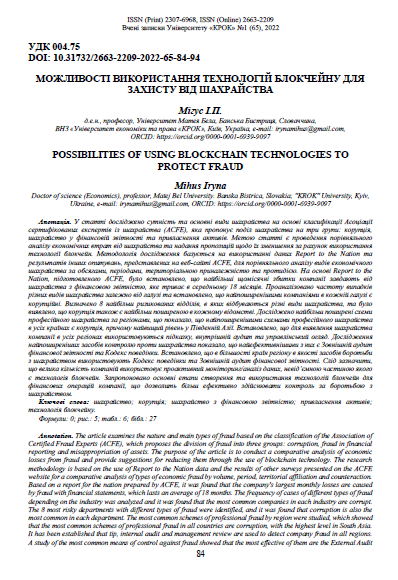POSSIBILITIES OF USING BLOCKCHAIN TECHNOLOGIES TO PROTECT FRAUD
DOI:
https://doi.org/10.31732/2663-2209-2022-65-84-94Keywords:
fraud, corruption, fraud with financial statements, appropriation of assets, blockchain technologyAbstract
The article examines the nature and main types of fraud based on the classification of the Association of Certified Fraud Experts (ACFE), which proposes the division of fraud into three groups: corruption, fraud in financial reporting and misappropriation of assets. The purpose of the article is to conduct a comparative analysis of economic losses from fraud and provide suggestions for reducing them through the use of blockchain technology. The research methodology is based on the use of Report to the Nation data and the results of other surveys presented on the ACFE website for a comparative analysis of types of economic fraud by volume, period, territorial affiliation and counteraction. Based on a report for the nation prepared by ACFE, it was found that the company's largest monthly losses are caused by fraud with financial statements, which lasts an average of 18 months. The frequency of cases of different types of fraud depending on the industry was analyzed and it was found that the most common companies in each industry are corrupt. The 8 most risky departments with different types of fraud were identified, and it was found that corruption is also the most common in each department. The most common schemes of professional fraud by region were studied, which showed that the most common schemes of professional fraud in all countries are corruption, with the highest level in South Asia. It has been established that tip, internal audit and management review are used to detect company fraud in all regions. A study of the most common means of control against fraud showed that the most effective of them are the External Audit of Financial Statements and the Code of Conduct. It has been established that in most countries of the region the Code of Conduct and the External Audit of Financial Statements are used as anti-fraud tools. It should be noted that a large number of companies use proactive monitoring / analysis of data, of which blockchain technology is an integral part. The main stages of creation and use of blockchain technologies for the financial operations of the company are offered, which will allow more effective control over the fight against fraud.
Downloads
References
Cooper, D. J., Dacin, T., & Palmer, D. (2013), “Fraud in accounting, organizations and society: Extending the boundaries of research”, Accounting, Organizations and Society, №38, рр. 440–457.
Taylor, J. (2007), “Company fraud in Victorian Britain: The Royal British Bank scandal of 1856”, The English Historical Review, №122, рр. 700–724.
Toms, S. (2017), Fraud and financial scandals. In J. F. Wilson, S. Toms, A. de Jong, & E. Buchnea (Eds.), The Routledge Companion to business history and New York: Routledge. pp. 358–372. Abingdon.
Biegelman, Martin T. (2013), Faces of Fraud: Cases and Lessons from a Life Fighting Fraudsters. Hoboken, NJ: Wiley.
Goldmann, Peter (2010), Fraud in the Markets: Why It Happens and How to Fight It. Hoboken, NJ: Wiley.
Comer, Michael J. (2003), Investigating Corporate Fraud. Aldershot, UK: Gower Publishing.
O’Gara, J. D. (2004), Corporate Fraud: Case Studies in Detection and Prevention. Hoboken, NJ: Wiley.
Pontell, Henry N., Alexander Frid, (2000), International Financial Fraud: Emerging Trends and Issues. In: Delbert L. Rounds (ed.), International Criminal Justice: Issues in a Global Perspective. Need-ham Heights, MA: Allyn & Bacon, рр. 32-47.
Young, Michael R. (2006), Accounting Irregularities and Financial Fraud: A Corporate Governance Guide. 3rd edition. Chicago: CCH.
Harrington, Brooke, (2012), The Sociology of Financial Fraud. In: Karin Knorr Cetina/Alex Preda (eds.). The Oxford Handbook of the Sociology of Finance. Oxford: Oxford University Press, рр. 393–410.
Gough, Leo (2013), The Con Men: A History of Financial Fraud and the Lessons You Can Learn. Harlow, UK: Pearson Education.
Cronin, Julia K. Amanda R. Evansburg Sylvia R. Garfinkle-Huff, (2001), Securities Fraud. In: American Criminal Law Review. №38, рр. 1277–1343.
Wang, Ke. (2010), Securities Fraud, 1996–2001: Incentive Pay, Governance, and Class Action Lawsuits. El Paso: LFB Scholarly Publishing.
Straney, Louis L. (2011), Securities Fraud: Detection, Prevention and Control. Hoboken, NJ: Wiley.
Yu, Xiaoyun (2013), “Securities Fraud and Corporate Finance: Recent Developments”, Managerial and Decision Economics. №34, рр. 439–450.
Henselmann, Klaus and Stefan Hofmann (2010), Accounting Fraud: Case Studies and Practical Implications. Berlin: Erich Schmidt Verlag.
Kat, Micha and Pieter Lakeman (2010), Boekhoudfraude: 13 schokkende fraudezaken in binnenen buitenland. Den Dolder, Netherlands: Belfra Publishers for Success.
Zack, Gerard M. (2013), Financial Statement Fraud: Strategies for Detection and Investigation. Hoboken, NJ: Wiley.
Pontell, Henry N. Kitty Calavita Robert Tillman (1994), “Corporate Crime and Criminal Justice System Capacity”, Government Response to Financial Institution Fraud. Justice Quarterly, №11, рр. 83–410.
Shepherd, Matthew J. Scott N. Wagner Natasha M. Williams (2001), “Financial Institutions Fraud”, American Criminal Law Review, №38, рр. 843–890.
Rosoff, Stephen Henry Pontell Robert Tillman, (2014), Profit without Honor: White-Collar Crime and the Looting of America. Upper Saddle River, Pearson Education.
Subramanian, Revathi, (2014), Bank Fraud: Using Technology to Combat Losses. Hoboken, NJ: Wiley.
Naylor, R. Thomas, (2007), The Alchemy of Fraud: Investment Scams in the Precious-metals Mining Business. Crime, Law and Social Change, №47, рр. 89–120.
Stoneman, Trace Pride/Douglas J. Schulz, 2002: Brokerage Fraud: What Wall Street Doesn’t Want You to Know. Chicago: Dearborn Trade Publishing.
Viaene, Stijn/Guido Dedene (2004), “Insurance Fraud: Issues and Challenges”, The Geneva Papers on Risk and Insurance: Issues and Practice, №29, рр. 313–333.
Report to the Nations. Retrieved from : www.acfe.com.
Mihus, I. (2020), Corporate fraudsters: who are they? In International Conference on Corporation Management. Retrieved from : https://conf.scnchub.com/index.php/ICCM/ICCM-2020/paper/view/142.

Downloads
Published
How to Cite
Issue
Section
License
Copyright (c) 2022 Science Notes of KROK University

This work is licensed under a Creative Commons Attribution 4.0 International License.

